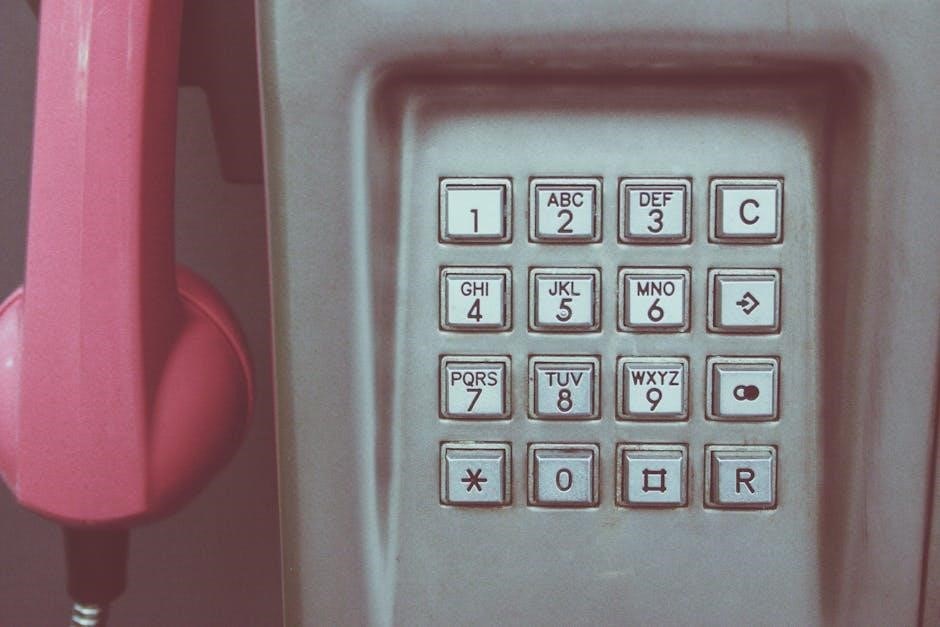The Kenwood KR-7400 is a high-grade stereo receiver from the NEW KR series, known for its advanced tuner and amplifier sections. It features a 4-gang variable capacitor, LED dial pointer, and MOS FETs for superior performance. The 36-page service manual provides detailed disassembly, circuit descriptions, and adjustment guidelines, making it essential for servicing. With a robust build and precise engineering, the KR-7400 is a sought-after model among audio enthusiasts.
1.1 Overview of the KR-7400 Model
The Kenwood KR-7400 is a high-performance AM/FM stereo receiver from the NEW KR series, designed for exceptional sound quality and reliability. It features a robust design with advanced components, including a frequency-linear 4-gang variable capacitor and MOS FETs in the front end. The receiver is popular among audio enthusiasts for its precise engineering and durability. A 36-page service manual is available, providing detailed guidance for maintenance and repairs, ensuring longevity and optimal performance of the unit.
1.2 Key Features and Specifications
The Kenwood KR-7400 boasts a range of impressive features, including a frequency-linear 4-gang variable capacitor, an LED dial pointer, and linear scaled front dial calibrations for precise tuning. It incorporates three MOS FETs in the front end for enhanced signal reception. The receiver delivers 63 watts per channel into 8Ω with a total harmonic distortion of 0.3%. Its dimensions are 480 x 151 x 344mm, making it a compact yet powerful addition to any home audio system, ensuring high-quality sound reproduction.

Tuner Section Architecture
The tuner section features a frequency-linear 4-gang variable capacitor, LED dial pointer, and 3 MOS FETs for improved signal handling. It also includes a local oscillator with buffer amplifier and PLL MPX stage for precise stereo decoding.

2.1 Frequency Linear 4 Gangs Variable Capacitor
The Kenwood KR-7400 features a frequency-linear 4-gang variable capacitor in its tuner section, ensuring precise and stable tuning across the FM and MW bands. This component provides smooth dial tracking and consistent signal reception, minimizing distortion and interference. Its linear scaling allows for accurate station calibration, enhancing overall listening clarity. The 4-gang design enables simultaneous tuning of multiple circuits, making it a key element in the receiver’s robust performance and reliability.
2.2 LED Dial Pointer and Front Dial Calibrations
The KR-7400 incorporates an LED dial pointer for precise visual tuning indication, enhancing user experience. The front dial calibrations are linearly scaled, ensuring accurate alignment with station frequencies. This combination allows for intuitive and exact tuning adjustments, providing clear and reliable operation. The LED pointer’s brightness and alignment are critical for optimal performance, as detailed in the service manual.
2.3 MOS FETs in the Front End
The KR-7400 utilizes 3 MOS FETs in its front-end circuitry, enhancing sensitivity and minimizing noise interference. These components are crucial for precise signal reception and processing. The MOS FETs contribute to the receiver’s high-performance tuning capabilities, ensuring stable and clear audio output. Detailed circuit descriptions and adjustments for these components are outlined in the service manual, aiding technicians in maintaining optimal functionality and addressing potential issues effectively.
Amplifier Section Details
The KR-7400 delivers 63 watts per channel with 0.3% harmonic distortion, a damping factor of 50, and a signal-to-noise ratio of 65dB (mic), 70dB (MM), 90dB (DIN), and 90dB (line). The service manual details these specifications and provides circuit descriptions and adjustment guidelines for optimal performance and maintenance.
3.1 Power Output and Harmonic Distortion
The Kenwood KR-7400 delivers a robust power output of 63 watts per channel into 8Ω (stereo) with a total harmonic distortion of 0.3%. This ensures clear and precise audio reproduction, maintaining high fidelity across various listening conditions. The service manual specifies these performance metrics, providing detailed insights into the amplifier’s capabilities and operational parameters, essential for both users and technicians seeking to understand or repair the unit.
3.2 Damping Factor and Signal-to-Noise Ratio
The Kenwood KR-7400 boasts an impressive damping factor of 50, ensuring tight bass control and accurate speaker performance. Its signal-to-noise ratio is 65dB (mic), 70dB (MM), 90dB (DIN), and 90dB (line), providing clean and quiet audio reproduction. These specifications highlight the receiver’s ability to minimize noise and deliver clear sound, making it a reliable choice for audiophiles seeking high-quality performance. The service manual details these metrics, ensuring optimal setup and maintenance.
Service Manual Overview
The Kenwood KR-7400 service manual spans 36 pages, detailing disassembly, circuit descriptions, and adjustments. It provides essential repair information, making it a vital resource for technicians and enthusiasts.
4.1 Contents of the 36-Page Service Manual
The 36-page service manual for the Kenwood KR-7400 provides comprehensive details for servicing and repair. It includes disassembly instructions, circuit descriptions, and adjustment procedures. The manual features block diagrams, tone amplifier circuits, and protection circuit explanations. Pages 6-10 cover disassembly, cord stringing, and protection circuits, while subsequent sections detail tone amp adjustments and circuit components. This resource is invaluable for technicians and enthusiasts, offering precise repair guidance and technical specifications to maintain optimal performance.
4.2 Disassembly and Circuit Descriptions
The service manual provides detailed disassembly instructions, starting from page 6, outlining the steps for safe removal of components. Circuit descriptions are thorough, with block diagrams and schematics to aid in understanding the internal layout. Pages 7-8 focus on the tuner and amplifier sections, while page 9 covers the tone amplifier circuit. This section is crucial for technicians, offering clear guidance for servicing and repairing the KR-7400 effectively.
4.3 Adjustments and Protection Circuits
The service manual details adjustments for optimal performance, including DC offset and tuner alignment. Protection circuits are explained to prevent damage from overload or short circuits. Page 10 focuses on these protective measures, ensuring safe operation. The manual guides technicians through precise calibration steps, maintaining the KR-7400’s reliability and sound quality. These adjustments are vital for long-term functionality and troubleshooting common issues effectively.

Repair and Troubleshooting
The service manual provides detailed repair guidance, including disassembly steps and circuit descriptions. It helps identify common issues and solutions, ensuring effective troubleshooting and maintenance.
5.1 Common Issues and Solutions
The Kenwood KR-7400 service manual highlights common issues such as capacitor degradation and dial calibration misalignment; Solutions include replacing faulty capacitors, adjusting the front dial, and ensuring proper MOS FET operation. The manual provides step-by-step guidance for troubleshooting and repairing these issues, ensuring optimal performance restoration. Regular maintenance and proper handling are emphasized to prevent recurring problems and extend the receiver’s lifespan.
5.2 Tools and Materials Required
Repairing the Kenwood KR-7400 requires tools like a soldering iron, desoldering pump, and precision screwdrivers. Materials include replacement capacitors, transistors, and resistors. A multimeter is essential for diagnosing issues, while a signal generator aids in tuning adjustments. Cleaning supplies like isopropyl alcohol and a soft brush are recommended for maintenance. Ensure all components match original specifications to maintain performance. Refer to the service manual for detailed part numbers and circuit diagrams.
Technical Specifications
The Kenwood KR-7400 features a damping factor of 50, signal-to-noise ratio of 65dB (mic), 70dB (MM), 90dB (DIN), and dimensions of 480 x 151 x 344mm.
6.1 Tuning Range and Frequency Response
The Kenwood KR-7400 offers a tuning range covering FM and MW frequencies, ensuring precise station selection. Its frequency response spans 10Hz to 40kHz, delivering clear and accurate sound reproduction. The tuner section features a frequency-linear 4-gang variable capacitor and MOS FETs for enhanced sensitivity and stability. With a total harmonic distortion of 0.3%, the receiver ensures high-fidelity audio output, making it a reliable choice for audiophiles seeking quality performance across its operational spectrum.
6.2 Output Levels and Dimensions
The Kenwood KR-7400 delivers output levels of 150mV (line), 30mV (DIN), and 150mV (pre-out), ensuring compatibility with various audio systems. Its dimensions are 480 x 151 x 344mm, making it a compact yet robust addition to home audio setups. These specifications highlight the receiver’s balance of power and space efficiency, catering to both performance and practicality for audiophiles seeking a reliable and versatile unit.
Collectibility and Market Value
The Kenwood KR-7400 is highly sought after by audio enthusiasts due to its superior build quality and performance, making it a valuable collectible. Its market value is influenced by condition, rarity, and functional accuracy, appealing to both vintage audio collectors and discerning audiophiles.
7.1 Popularity Among Audio Enthusiasts
The Kenwood KR-7400 holds significant appeal among audio enthusiasts due to its exceptional performance, robust construction, and classic design. Its advanced tuner section with a 4-gang variable capacitor and MOS FETs ensures precise tuning and high-quality audio reproduction. Additionally, the availability of detailed service manuals and repair guides makes it a favorite among hobbyists and restorers. This model’s combination of power, clarity, and reliability continues to attract collectors and audiophiles worldwide.
7.2 Factors Affecting Resale Value
The resale value of the Kenwood KR-7400 is influenced by its condition, rarity, and demand among collectors. Units with original packaging, minimal wear, and functional performance command higher prices. The availability of the service manual and ease of repair also impact value, as enthusiasts often seek restorable units. Additionally, the reputation of the KR series and its historical significance in audio technology contribute to its appeal and resale potential in the vintage electronics market.
Maintenance and Upkeep
Regular cleaning of controls and connections ensures optimal performance. Proper storage in a dry, cool environment prevents damage. Follow service manual guidelines for handling and calibration.
8.1 Cleaning and Calibration Tips
Regular cleaning of the KR-7400’s controls and connections with a soft cloth ensures optimal performance. Avoid harsh chemicals, as they may damage the finish or components. For calibration, align the dial pointer with the tuning knob carefully. Check and adjust the front dial calibrations as outlined in the service manual. Proper calibration ensures accurate tuning and maintains the receiver’s precise functionality over time.
8.2 Proper Storage and Handling
Store the Kenwood KR-7400 in a cool, dry place away from direct sunlight to prevent overheating. Use the original packaging or a sturdy box to protect against physical damage. Avoid exposing the unit to extreme temperatures or humidity. Handle with care to prevent shocks or drops. Keep the receiver upright to ensure proper ventilation. For transportation, secure it tightly to avoid movement. Always disconnect power before moving or storing to protect internal components and ensure longevity.
The Kenwood KR-7400 receiver stands out for its robust design, advanced tuner, and amplifier sections. Its service manual is indispensable for maintenance and repairs, ensuring optimal performance and longevity.

9.1 Final Thoughts on the KR-7400
The Kenwood KR-7400 is a standout receiver in its class, blending robust construction with advanced features like the 4-gang variable capacitor and MOS FETs. Its 36-page service manual is a comprehensive resource for technicians and enthusiasts, detailing disassembly, circuitry, and adjustments. With its strong build quality and precise engineering, the KR-7400 remains a favorite among collectors and audio enthusiasts, ensuring its legacy as a high-performance vintage receiver.
9.2 Importance of the Service Manual
The Kenwood KR-7400 service manual is a vital resource for technicians and enthusiasts, providing detailed insights into disassembly, circuit descriptions, and adjustments. It ensures precise repairs, troubleshooting, and maintenance, helping maintain the receiver’s performance and longevity. The manual’s comprehensive guidance is essential for preserving the KR-7400’s functionality and value, making it indispensable for anyone working with this high-quality vintage audio equipment.
